Sociological Aspect of Cyber-Bullying
VerifiedAdded on 2023/06/11
|6
|1562
|328
AI Summary
This essay focuses on the impact of internet and how cyber-bullying has become a menace for the modern world. The essay also attempts to present a sociological analysis to the impact of cyber-bullying.
Contribute Materials
Your contribution can guide someone’s learning journey. Share your
documents today.
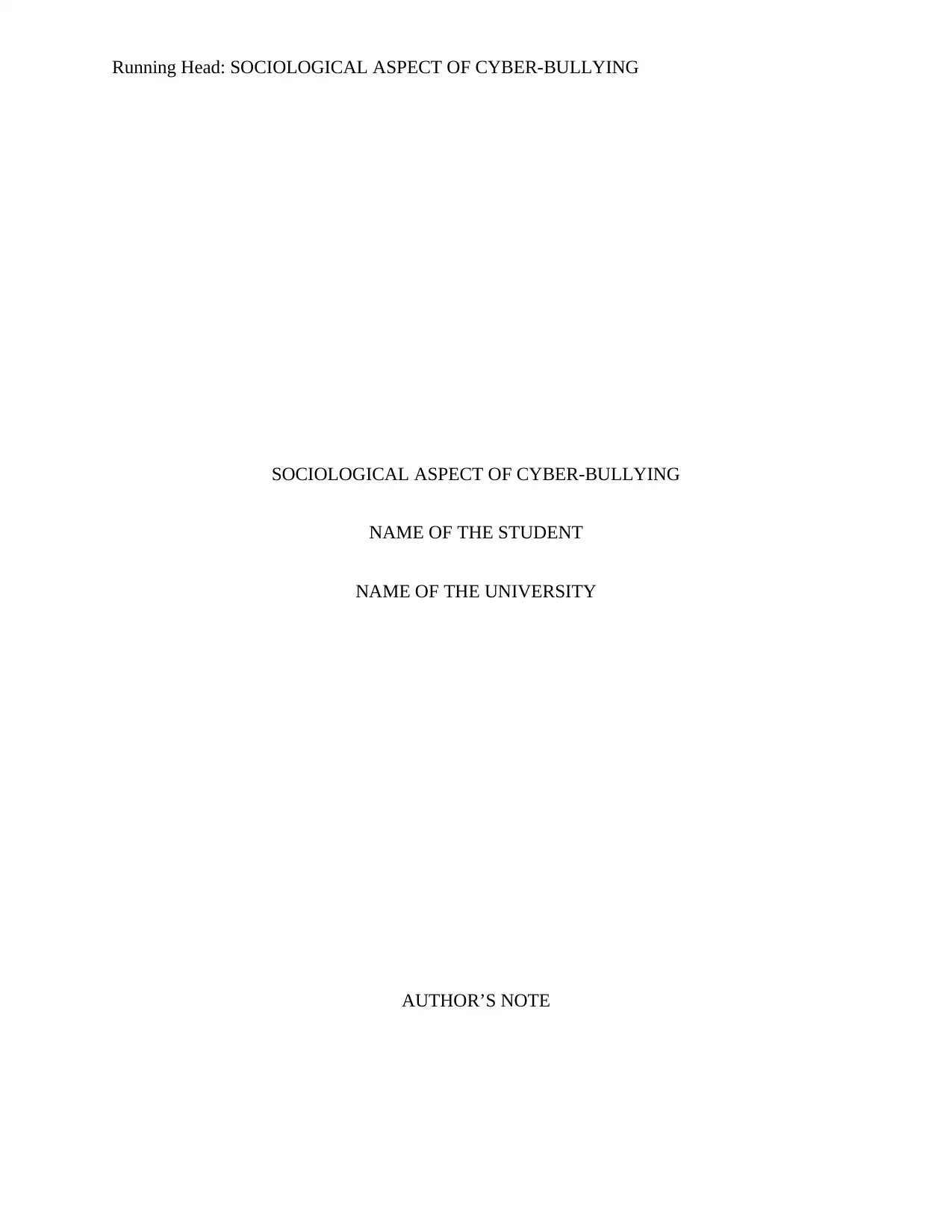
Running Head: SOCIOLOGICAL ASPECT OF CYBER-BULLYING
SOCIOLOGICAL ASPECT OF CYBER-BULLYING
NAME OF THE STUDENT
NAME OF THE UNIVERSITY
AUTHOR’S NOTE
SOCIOLOGICAL ASPECT OF CYBER-BULLYING
NAME OF THE STUDENT
NAME OF THE UNIVERSITY
AUTHOR’S NOTE
Secure Best Marks with AI Grader
Need help grading? Try our AI Grader for instant feedback on your assignments.

1SO CIOLOGICAL ASPECT OF CYBER-BULLYING
The advent of the internet and the online platform has opened a plethora of opportunities
for the common people. The people who had no scope of interacting with the outside world and
who were residing in the remote areas got an opportunity to widen their interaction and
communication with the outside world as well as gain access to a wide range of information. The
internet and online services have virtually made the world a global village. At the same time, the
negative impact of cyber-bullying has also increased with the internet usage. The essay focuses
on the impact of internet and how cyber-bullying has become a menace for the modern world.
The essay also attempts to present a sociological analysis to the impact of cyber-bullying.
Cyber-bullying is a type of harassing or bullying a person on the online platform. Cyber
bullying is also referred to as online bullying. Cyber bullying occurs when a person, normally the
young adults or the teens, indulge in the act of harassing or abusing another person in the online
social networking sites or online platforms (Boulton et al., 2014). The penetration of the online
social networking sites has enabled the users to have access to a wide range of opinions and
perceptions. The perpetrators of the cyber bullying actually inflict harm upon the person by
harassing, exclusion, impersonification, stalking as well as spreading rumors, sexual remarks,
threatening, leaking the personal information and threatening to inflict harm or rape the victim
(Pabian & Vandebosch, 2016). The Bullying can be identified as the repetition of the harmful
behavior, which is done with intent to inflict harm to the person concerned. The victims of the
Cyber-Bullying are usually identified as having lower self-esteem and have increased suicidal
tendencies. The common psychological factors, which affect the victims of cyber-bullying,
involve feeling afraid, angry, frustrated as well as depressed.
The Conflict theory can be used to explain the phenomenon of cyber-bullying. The
Conflict theory as has been stated by Karl Marx states that society is always in a condition of
The advent of the internet and the online platform has opened a plethora of opportunities
for the common people. The people who had no scope of interacting with the outside world and
who were residing in the remote areas got an opportunity to widen their interaction and
communication with the outside world as well as gain access to a wide range of information. The
internet and online services have virtually made the world a global village. At the same time, the
negative impact of cyber-bullying has also increased with the internet usage. The essay focuses
on the impact of internet and how cyber-bullying has become a menace for the modern world.
The essay also attempts to present a sociological analysis to the impact of cyber-bullying.
Cyber-bullying is a type of harassing or bullying a person on the online platform. Cyber
bullying is also referred to as online bullying. Cyber bullying occurs when a person, normally the
young adults or the teens, indulge in the act of harassing or abusing another person in the online
social networking sites or online platforms (Boulton et al., 2014). The penetration of the online
social networking sites has enabled the users to have access to a wide range of opinions and
perceptions. The perpetrators of the cyber bullying actually inflict harm upon the person by
harassing, exclusion, impersonification, stalking as well as spreading rumors, sexual remarks,
threatening, leaking the personal information and threatening to inflict harm or rape the victim
(Pabian & Vandebosch, 2016). The Bullying can be identified as the repetition of the harmful
behavior, which is done with intent to inflict harm to the person concerned. The victims of the
Cyber-Bullying are usually identified as having lower self-esteem and have increased suicidal
tendencies. The common psychological factors, which affect the victims of cyber-bullying,
involve feeling afraid, angry, frustrated as well as depressed.
The Conflict theory can be used to explain the phenomenon of cyber-bullying. The
Conflict theory as has been stated by Karl Marx states that society is always in a condition of
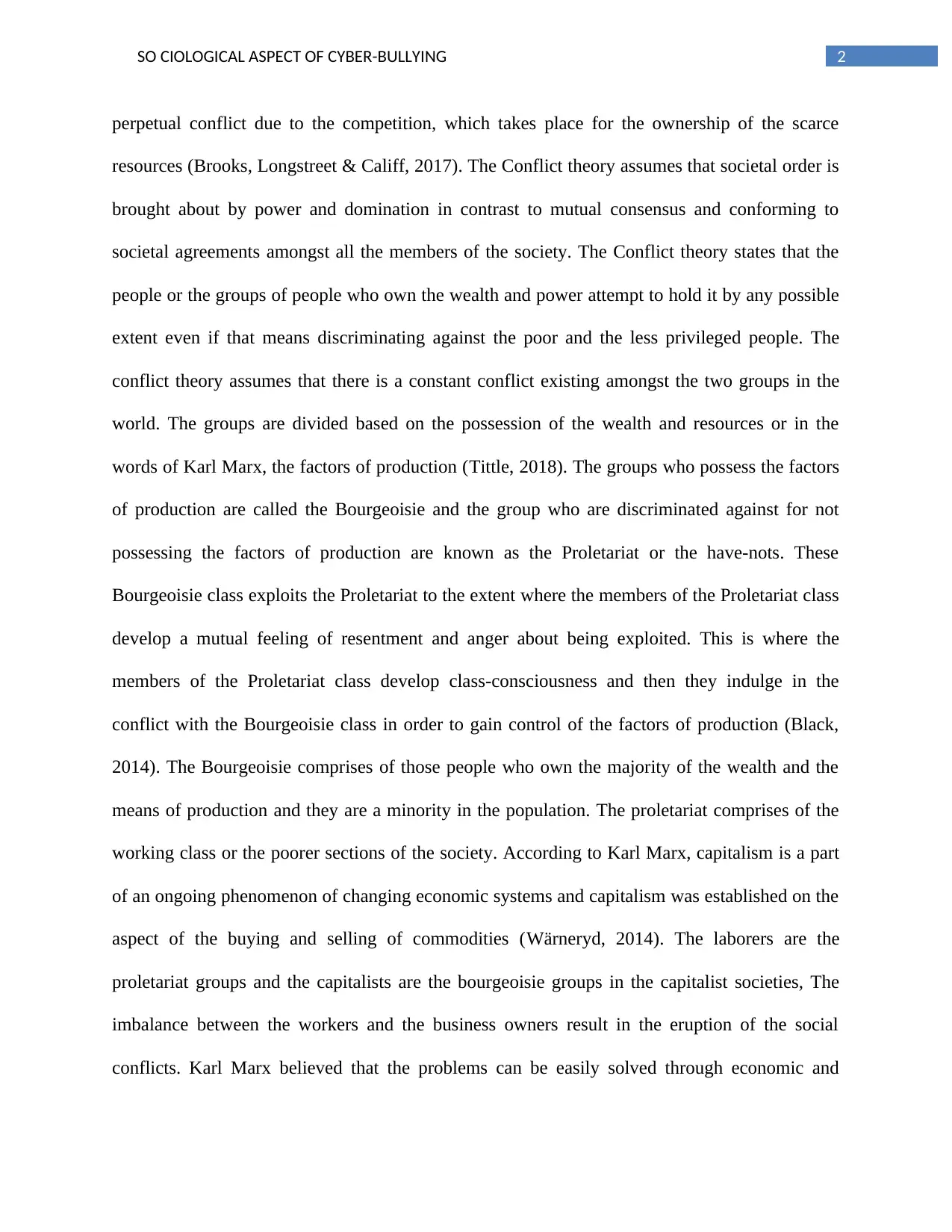
2SO CIOLOGICAL ASPECT OF CYBER-BULLYING
perpetual conflict due to the competition, which takes place for the ownership of the scarce
resources (Brooks, Longstreet & Califf, 2017). The Conflict theory assumes that societal order is
brought about by power and domination in contrast to mutual consensus and conforming to
societal agreements amongst all the members of the society. The Conflict theory states that the
people or the groups of people who own the wealth and power attempt to hold it by any possible
extent even if that means discriminating against the poor and the less privileged people. The
conflict theory assumes that there is a constant conflict existing amongst the two groups in the
world. The groups are divided based on the possession of the wealth and resources or in the
words of Karl Marx, the factors of production (Tittle, 2018). The groups who possess the factors
of production are called the Bourgeoisie and the group who are discriminated against for not
possessing the factors of production are known as the Proletariat or the have-nots. These
Bourgeoisie class exploits the Proletariat to the extent where the members of the Proletariat class
develop a mutual feeling of resentment and anger about being exploited. This is where the
members of the Proletariat class develop class-consciousness and then they indulge in the
conflict with the Bourgeoisie class in order to gain control of the factors of production (Black,
2014). The Bourgeoisie comprises of those people who own the majority of the wealth and the
means of production and they are a minority in the population. The proletariat comprises of the
working class or the poorer sections of the society. According to Karl Marx, capitalism is a part
of an ongoing phenomenon of changing economic systems and capitalism was established on the
aspect of the buying and selling of commodities (Wärneryd, 2014). The laborers are the
proletariat groups and the capitalists are the bourgeoisie groups in the capitalist societies, The
imbalance between the workers and the business owners result in the eruption of the social
conflicts. Karl Marx believed that the problems can be easily solved through economic and
perpetual conflict due to the competition, which takes place for the ownership of the scarce
resources (Brooks, Longstreet & Califf, 2017). The Conflict theory assumes that societal order is
brought about by power and domination in contrast to mutual consensus and conforming to
societal agreements amongst all the members of the society. The Conflict theory states that the
people or the groups of people who own the wealth and power attempt to hold it by any possible
extent even if that means discriminating against the poor and the less privileged people. The
conflict theory assumes that there is a constant conflict existing amongst the two groups in the
world. The groups are divided based on the possession of the wealth and resources or in the
words of Karl Marx, the factors of production (Tittle, 2018). The groups who possess the factors
of production are called the Bourgeoisie and the group who are discriminated against for not
possessing the factors of production are known as the Proletariat or the have-nots. These
Bourgeoisie class exploits the Proletariat to the extent where the members of the Proletariat class
develop a mutual feeling of resentment and anger about being exploited. This is where the
members of the Proletariat class develop class-consciousness and then they indulge in the
conflict with the Bourgeoisie class in order to gain control of the factors of production (Black,
2014). The Bourgeoisie comprises of those people who own the majority of the wealth and the
means of production and they are a minority in the population. The proletariat comprises of the
working class or the poorer sections of the society. According to Karl Marx, capitalism is a part
of an ongoing phenomenon of changing economic systems and capitalism was established on the
aspect of the buying and selling of commodities (Wärneryd, 2014). The laborers are the
proletariat groups and the capitalists are the bourgeoisie groups in the capitalist societies, The
imbalance between the workers and the business owners result in the eruption of the social
conflicts. Karl Marx believed that the problems can be easily solved through economic and
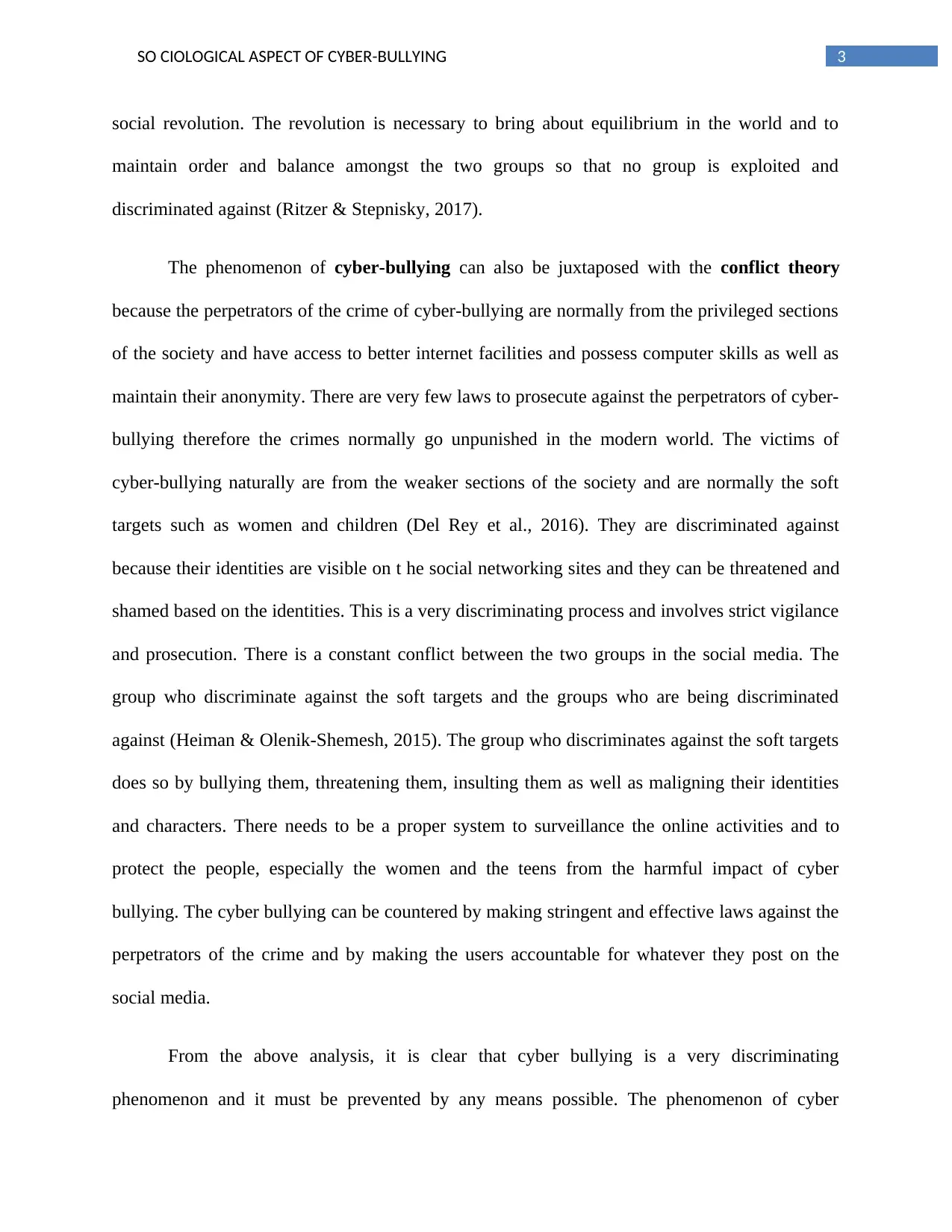
3SO CIOLOGICAL ASPECT OF CYBER-BULLYING
social revolution. The revolution is necessary to bring about equilibrium in the world and to
maintain order and balance amongst the two groups so that no group is exploited and
discriminated against (Ritzer & Stepnisky, 2017).
The phenomenon of cyber-bullying can also be juxtaposed with the conflict theory
because the perpetrators of the crime of cyber-bullying are normally from the privileged sections
of the society and have access to better internet facilities and possess computer skills as well as
maintain their anonymity. There are very few laws to prosecute against the perpetrators of cyber-
bullying therefore the crimes normally go unpunished in the modern world. The victims of
cyber-bullying naturally are from the weaker sections of the society and are normally the soft
targets such as women and children (Del Rey et al., 2016). They are discriminated against
because their identities are visible on t he social networking sites and they can be threatened and
shamed based on the identities. This is a very discriminating process and involves strict vigilance
and prosecution. There is a constant conflict between the two groups in the social media. The
group who discriminate against the soft targets and the groups who are being discriminated
against (Heiman & Olenik-Shemesh, 2015). The group who discriminates against the soft targets
does so by bullying them, threatening them, insulting them as well as maligning their identities
and characters. There needs to be a proper system to surveillance the online activities and to
protect the people, especially the women and the teens from the harmful impact of cyber
bullying. The cyber bullying can be countered by making stringent and effective laws against the
perpetrators of the crime and by making the users accountable for whatever they post on the
social media.
From the above analysis, it is clear that cyber bullying is a very discriminating
phenomenon and it must be prevented by any means possible. The phenomenon of cyber
social revolution. The revolution is necessary to bring about equilibrium in the world and to
maintain order and balance amongst the two groups so that no group is exploited and
discriminated against (Ritzer & Stepnisky, 2017).
The phenomenon of cyber-bullying can also be juxtaposed with the conflict theory
because the perpetrators of the crime of cyber-bullying are normally from the privileged sections
of the society and have access to better internet facilities and possess computer skills as well as
maintain their anonymity. There are very few laws to prosecute against the perpetrators of cyber-
bullying therefore the crimes normally go unpunished in the modern world. The victims of
cyber-bullying naturally are from the weaker sections of the society and are normally the soft
targets such as women and children (Del Rey et al., 2016). They are discriminated against
because their identities are visible on t he social networking sites and they can be threatened and
shamed based on the identities. This is a very discriminating process and involves strict vigilance
and prosecution. There is a constant conflict between the two groups in the social media. The
group who discriminate against the soft targets and the groups who are being discriminated
against (Heiman & Olenik-Shemesh, 2015). The group who discriminates against the soft targets
does so by bullying them, threatening them, insulting them as well as maligning their identities
and characters. There needs to be a proper system to surveillance the online activities and to
protect the people, especially the women and the teens from the harmful impact of cyber
bullying. The cyber bullying can be countered by making stringent and effective laws against the
perpetrators of the crime and by making the users accountable for whatever they post on the
social media.
From the above analysis, it is clear that cyber bullying is a very discriminating
phenomenon and it must be prevented by any means possible. The phenomenon of cyber
Secure Best Marks with AI Grader
Need help grading? Try our AI Grader for instant feedback on your assignments.
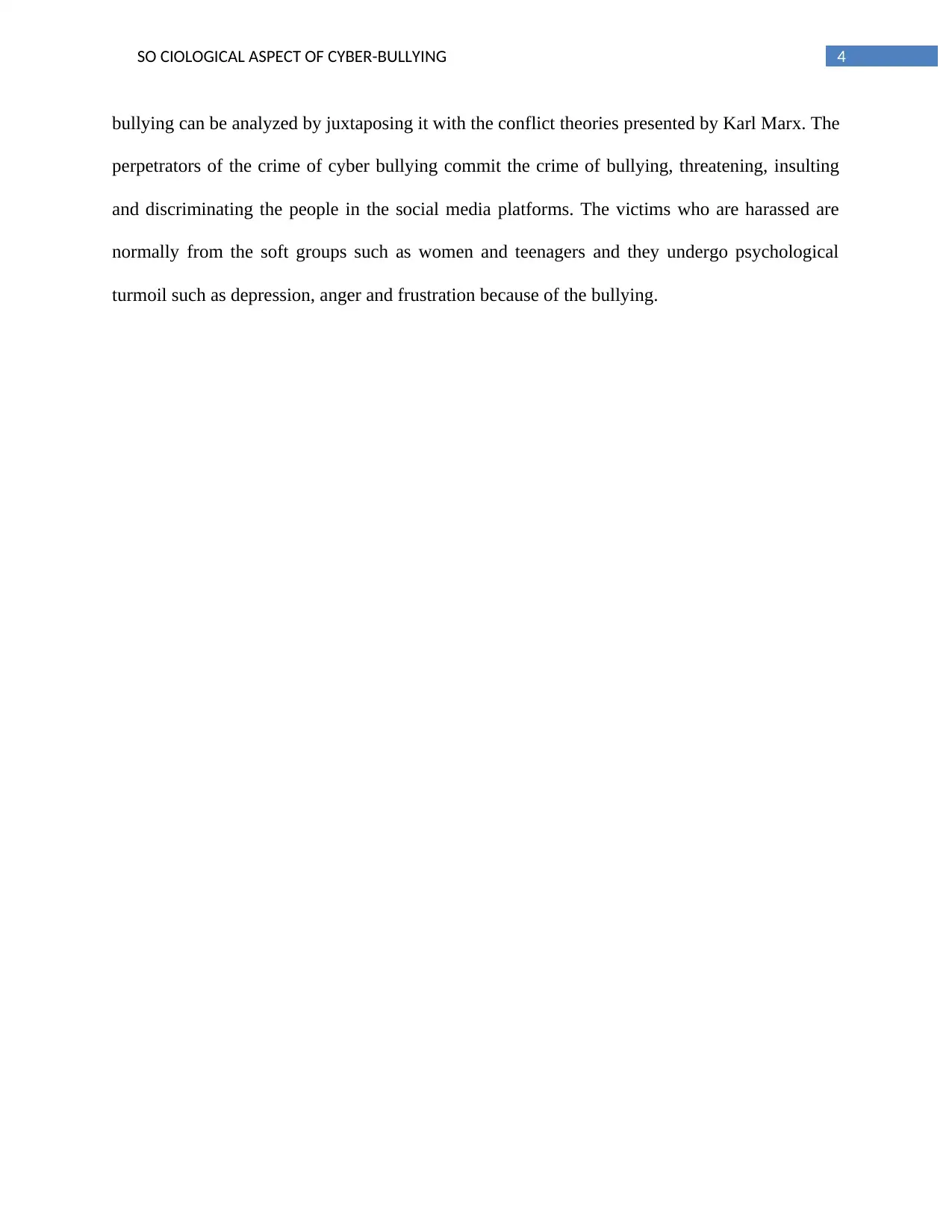
4SO CIOLOGICAL ASPECT OF CYBER-BULLYING
bullying can be analyzed by juxtaposing it with the conflict theories presented by Karl Marx. The
perpetrators of the crime of cyber bullying commit the crime of bullying, threatening, insulting
and discriminating the people in the social media platforms. The victims who are harassed are
normally from the soft groups such as women and teenagers and they undergo psychological
turmoil such as depression, anger and frustration because of the bullying.
bullying can be analyzed by juxtaposing it with the conflict theories presented by Karl Marx. The
perpetrators of the crime of cyber bullying commit the crime of bullying, threatening, insulting
and discriminating the people in the social media platforms. The victims who are harassed are
normally from the soft groups such as women and teenagers and they undergo psychological
turmoil such as depression, anger and frustration because of the bullying.
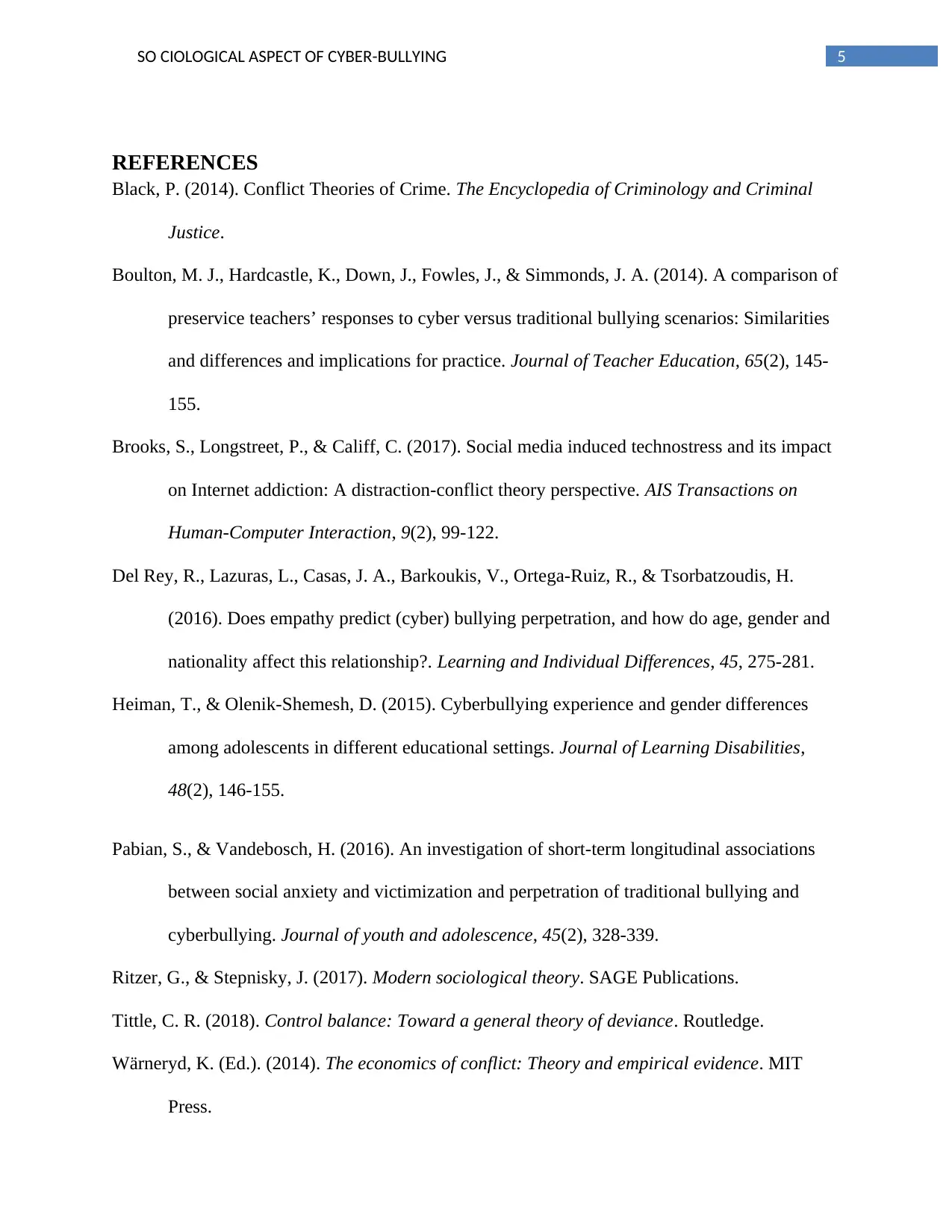
5SO CIOLOGICAL ASPECT OF CYBER-BULLYING
REFERENCES
Black, P. (2014). Conflict Theories of Crime. The Encyclopedia of Criminology and Criminal
Justice.
Boulton, M. J., Hardcastle, K., Down, J., Fowles, J., & Simmonds, J. A. (2014). A comparison of
preservice teachers’ responses to cyber versus traditional bullying scenarios: Similarities
and differences and implications for practice. Journal of Teacher Education, 65(2), 145-
155.
Brooks, S., Longstreet, P., & Califf, C. (2017). Social media induced technostress and its impact
on Internet addiction: A distraction-conflict theory perspective. AIS Transactions on
Human-Computer Interaction, 9(2), 99-122.
Del Rey, R., Lazuras, L., Casas, J. A., Barkoukis, V., Ortega-Ruiz, R., & Tsorbatzoudis, H.
(2016). Does empathy predict (cyber) bullying perpetration, and how do age, gender and
nationality affect this relationship?. Learning and Individual Differences, 45, 275-281.
Heiman, T., & Olenik-Shemesh, D. (2015). Cyberbullying experience and gender differences
among adolescents in different educational settings. Journal of Learning Disabilities,
48(2), 146-155.
Pabian, S., & Vandebosch, H. (2016). An investigation of short-term longitudinal associations
between social anxiety and victimization and perpetration of traditional bullying and
cyberbullying. Journal of youth and adolescence, 45(2), 328-339.
Ritzer, G., & Stepnisky, J. (2017). Modern sociological theory. SAGE Publications.
Tittle, C. R. (2018). Control balance: Toward a general theory of deviance. Routledge.
Wärneryd, K. (Ed.). (2014). The economics of conflict: Theory and empirical evidence. MIT
Press.
REFERENCES
Black, P. (2014). Conflict Theories of Crime. The Encyclopedia of Criminology and Criminal
Justice.
Boulton, M. J., Hardcastle, K., Down, J., Fowles, J., & Simmonds, J. A. (2014). A comparison of
preservice teachers’ responses to cyber versus traditional bullying scenarios: Similarities
and differences and implications for practice. Journal of Teacher Education, 65(2), 145-
155.
Brooks, S., Longstreet, P., & Califf, C. (2017). Social media induced technostress and its impact
on Internet addiction: A distraction-conflict theory perspective. AIS Transactions on
Human-Computer Interaction, 9(2), 99-122.
Del Rey, R., Lazuras, L., Casas, J. A., Barkoukis, V., Ortega-Ruiz, R., & Tsorbatzoudis, H.
(2016). Does empathy predict (cyber) bullying perpetration, and how do age, gender and
nationality affect this relationship?. Learning and Individual Differences, 45, 275-281.
Heiman, T., & Olenik-Shemesh, D. (2015). Cyberbullying experience and gender differences
among adolescents in different educational settings. Journal of Learning Disabilities,
48(2), 146-155.
Pabian, S., & Vandebosch, H. (2016). An investigation of short-term longitudinal associations
between social anxiety and victimization and perpetration of traditional bullying and
cyberbullying. Journal of youth and adolescence, 45(2), 328-339.
Ritzer, G., & Stepnisky, J. (2017). Modern sociological theory. SAGE Publications.
Tittle, C. R. (2018). Control balance: Toward a general theory of deviance. Routledge.
Wärneryd, K. (Ed.). (2014). The economics of conflict: Theory and empirical evidence. MIT
Press.
1 out of 6
Related Documents
Your All-in-One AI-Powered Toolkit for Academic Success.
+13062052269
info@desklib.com
Available 24*7 on WhatsApp / Email
![[object Object]](/_next/static/media/star-bottom.7253800d.svg)
Unlock your academic potential
© 2024 | Zucol Services PVT LTD | All rights reserved.





